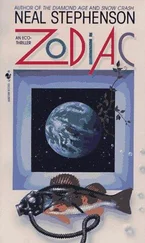The king took Dorji and Jigme by the hand, turning his back on the mourners or the well-wishers or whatever they were, and nodded at Doob as if to say “your move.”
Doob bowed one last time, then turned around and began leading them down the mountain.
DAY 306
Arklet 1, which had been sent up on Day 285, turned out to have a few teething problems with its maneuvering thrusters, and so the first bolo coupling in the history of the Cloud Ark took place between Arklet 2 and Arklet 3. Those had been launched on Days 296 and 300, respectively. These first three Arklets represented competing designs and so they all looked a little different. No matter; they were destined to be punched out in different factories and launched on different types of heavy-lift rockets from different spaceports, so minor variations in styling were to be expected. They all had the same general shape, though: a cylinder with domed end caps. That was for the ineluctable reason that they had to be pressurized in order to perform their basic function of keeping humans alive, and pressure sooner or later made everything round. Dinah thought that the pressure hulls looked like the big liquid propane tanks seen next to cabins and mobile homes in the rural mining camps where she had grown up. Others likened them to railway tanker cars, or stubby hot dogs.
They were just big aluminum cans with domes welded onto the ends. The walls of the can had a thickness of about a millimeter. The domes were a bit sturdier. The thickest and strongest parts of the hull were in the places where the domes overlapped the ends of the can. The analogy was to a plastic soda bottle, whose thin walls could be crumpled in one hand when the lid was off, but which became amazingly stiff and strong when it was pressurized. Or at least that was what NASA was saying to people who were alarmed by the idea of living one millimeter away from the vacuum of space.
The first three arklets were launched “naked” and smooth, but the hundreds to follow would come up clothed in translucent fabric jackets, pleated and wrinkled during the passage through the atmosphere, protected beneath fiberglass fairings. Once in space the blanket would be inflated to form a flexible outer hull somewhat larger than the inner one. It was in that inter-hull space where food would be grown, making use of sunlight that would diffuse through the fabric. It was not clear yet whether each arklet could be self-sufficient in terms of food production — probably not — but growing some food was better than growing none. Having some green stuff on board helped reduce the load on the CO 2scrubbers, and having water between humans and space helped stop some incoming radiation.
One of the end caps sported a docking port, designated in NASA public-relations cant as the “front door.” It was a bit of a misnomer since it was the only door. Once sealed up inside the pressure hull, the occupants could only get out of it by docking the arklet to something with breathable air on the other side of it.
The opposite end of the arklet was called the “boiler room.” Mounted outside of it was the trash-can-sized nuclear generator that supplied the arklet with power. Around that were various fittings for connection of plumbing lines, electrical mains, cooling equipment, and the like, none of which would ever be used except in the case when a number of arklets decided to dock themselves together and form a semipermanent cluster.
Those sturdy, thick rings where the domes met the main body served as attachment points for anything of a structural nature — anything that would exert significant forces on the body of the arklet. Radiating from each of those rings were eight stubby, radial spokes, extending outward to halolike rings where thrusters and grappling equipment were attached. Those parts were shipped inside of the arklet, then, once it was in space, extracted through the docking port by spacewalkers and bolted on in zero gee. The halos also served to stiffen and stabilize the inflatable outer hull in arklets so equipped, but in the first three test units they just projected out into space like bicycle rims, studded with small thruster nozzles and laced through with plumbing.
Spanning the distance between the “front door” halo and the “boiler room” halo was a single long spindly member, hinged at the “front” or forward end so that it could, on command, snap up and out, projecting sideways from the arklet for a distance of about ten meters. Mounted to the end of this arm were a camera, a target, and an electromechanical grappling device, collectively known as the Paw. A cable ran from the Paw back down the length of the arm to a reel near the docking port, where 250 meters of it were wound up like thread on a spool. The arm, the Paw, the rope, and the reel were all there to achieve a specific maneuver, never before attempted, denoted in official NASA engineering documents as the Bolo Coupling Operation but referred to everywhere else as the High Five.
On Day 306, after Arklets 2 and 3 had been assembled and checked out, the first Bolo Coupling Operation was initiated. It happened several kilometers away from Izzy. It was done quietly and secretly, in case it failed, but lots of video was taken, in case it succeeded. The operation had many possible failure modes, which was engineering-speak meaning that it could go wrong in so many different ways that trying to think them all through was impossible. So each of the two arklets needed to have a qualified pilot: someone who understood orbital mechanics and spaceship propulsion well enough to bring an errant craft back in hand by manual control. Few such people had ever existed, and only four of them were aboard Izzy. Right now, down on the ground, thousands of young people selected in the Casting of Lots were learning how to do it by piloting virtual arklets in video game simulations, but none of those people was ready, or in orbit, yet. So Ivy ended up at the controls of Arklet 2, with Dinah as passenger and general assistant. Piloting Arklet 3 was a recent arrival, Markus Leuker, a Swiss air force pilot turned astronaut and a veteran of two previous missions to the ISS. His background piloting high-performance fighter jets through Alpine valleys seemed like a reasonable qualification for this job. His assistant was Wang Fuhua, one of the first Chinese taikonauts to have reached Izzy during the Pioneer days of a few months back.
After a good night’s sleep and a light breakfast, the four participants met in the Banana to go over the details one last time with engineers on the ground, then ascended a spoke into the weightless environment of H1 and glided up the Stack — the central axis of the space station — snaking through work bays and temporary supply dumps until they reached a docking node that, after a few twists and turns, led them into a hamster tube. One after the other they slithered down it. Dinah, in number three position behind Markus, found it difficult to keep up with him; the soles of his feet kept getting farther and farther away. “Just like scaling the Daubenhorn,” he said at one point, “except without the annoyance of gravity!”
“Is that a mountain?” Dinah asked, since the hamster tube was long, and she felt that a bit of light conversation would help ease the lump in her stomach.
“Yes, a famous Klettersteig where I grew up — you must come and give it a try one of these days,” Markus called back.
A common error in etiquette, among people who had only recently arrived at Izzy, was to talk about Earth as a place that it was possible to go back to. As if this were a temporary mission like all of the previous ones. Dinah said nothing. Markus would realize his mistake, if he hadn’t already.
“Oh, well,” he added. Yes, he had realized it.
“What’s a Klettersteig ?” Dinah asked, trying to move on.
Читать дальше
Конец ознакомительного отрывка
Купить книгу





